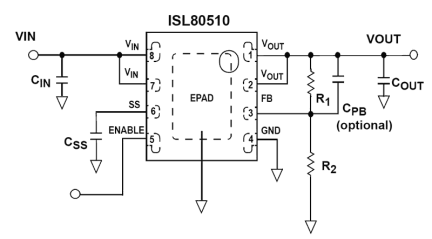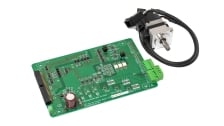Overview
Description
The ISL80510 is a single output Low Dropout voltage regulator (LDO) capable of sourcing up to 1A output current. This LDO operates from input voltages of 2. 2V to 6V. The output voltage of ISL80510 can be programmed from 0. 8V to 5. 5V. A submicron BiCMOS process is utilized for this product family to deliver the best in class analog performance and overall value. This CMOS LDO consumes significantly lower quiescent current as a function of load compared to bipolar LDOs, which translates into higher efficiency and packages with smaller footprints. State-of-the-art internal compensation achieves a very fast load transient response and excellent PSRR. The ISL80510 provides an output accuracy of ±1. 8% VOUT accuracy over all load, line and temperature variation (TJ = -40°C to +125°C). An external capacitor on the soft-start pin provides an adjustable soft starting of the output voltage ramp to control the inrush current. The ENABLE feature allows the part to be placed into a low quiescent current shutdown mode.
Features
- ±1.8% VOUT accuracy guaranteed over line, load and TJ = -40°C to +125°C
- Very low 130mV dropout voltage at VOUT = 2.5V
- Stable with a 4.7µF output ceramic capacitor
- Very fast transient response
- Programmable output soft-start time
- Excellent PSRR over wide frequency range
- Current limit protection
- Thermal shutdown function
- Available in an 8 Ld DFN package
- Pb-free (RoHS compliant)
Comparison
Applications
Documentation
|
|
|
|
|---|---|---|
| Type | Title | Date |
| Datasheet | PDF 1.08 MB | |
| Brochure | PDF 12.71 MB 日本語 | |
| Product Change Notice | PDF 169 KB | |
| White Paper | PDF 3.36 MB 简体中文 | |
| Product Change Notice | PDF 326 KB | |
| Application Note | PDF 509 KB | |
| Application Note | PDF 397 KB | |
7 items
|
||
Design & Development
Boards & Kits
RZ/T Series Inverter Board
The RZ/T Series Inverter Board (P/N: RTK0EM0000B15010BJ) is an inverter board that allows users to evaluate motor control using a BLDC motor with ease. This product...
RZ/T Series Inverter Board Kit
The RZ/T Series Inverter Board Kit (P/N: RTK0EM0000S05010BJ) is an inverter board that allows users to evaluate motor control using BLDC motor with ease. This product...
Models
ECAD Models
Schematic symbols, PCB footprints, and 3D CAD models from SamacSys can be found by clicking on products in the Product Options table. If a symbol or model isn't available, it can be requested directly from the website.

Product Options
Applied Filters:



